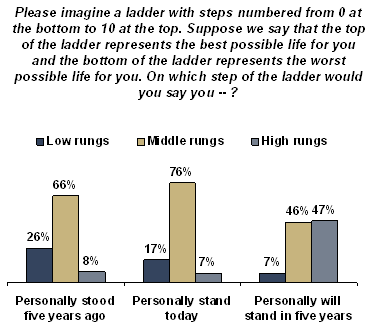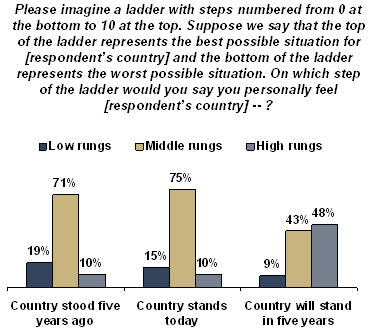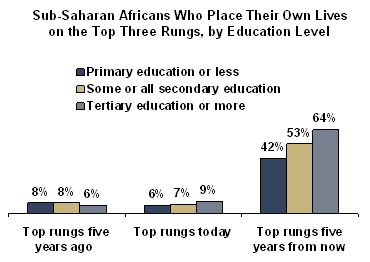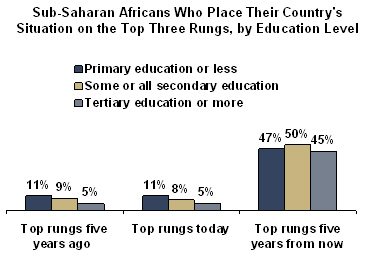GALLUP NEWS SERVICE
PRINCETON, NJ -- Given the poverty and disease most Africans grapple with daily, their level of optimism about the future is hard to believe. But it is real.
Consider the following Gallup World Poll results aggregated from 21 sub-Saharan African countries. Respondents were asked to use an 11-point Cantril Self-Anchoring Striving Scale to rate the status of their own lives today and five years ago, and then to predict where on the ladder they think their lives will be five years in the future. They then used the same scale to rate the status of their country as a whole in the past, present, and future. In order to help interpret the data, the ratings on the 11-point scale are combined into three groups: those choosing the bottom three rungs are assigned to the lowest group; those choosing the middle five are assigned to the middle group; and those choosing the top three are assigned to the upper group.
Though fewer than 1 in 10 respondents place their current or past lives on the high rungs, nearly half (47%) believe they will be in that range five years in the future. Results for the overall country ratings follow a similar pattern.


Gallup usually finds greater positivity toward the future than the past or present when this series of questions is asked throughout the world -- but in few regions are the gaps between the ratings of the present and future as wide as they typically are in sub-Saharan Africa. Indeed, the percentage predicting a high rung for their future is at least 15 points greater than the percentage who choose a high rung for the present in all but 1 of the 21 countries surveyed (the lone exception is Zimbabwe, where just 22% of residents place their own future status on an upper rung, and 13% put the country's future status on an upper rung.)
Who Is Most Optimistic?
Africans' optimism is relatively even across demographic groups, although education level is one differentiating factor: Those with the highest education levels are most optimistic about where they will stand in five years -- almost two-thirds (64%) pick one of the top rungs, compared with fewer than half (42%) of those with a primary education or less.

In respondents' ratings of their countries' situations, the pattern changes somewhat. Here, more highly educated Africans are not the most likely to be optimistic; in fact, they are slightly less likely to pick one of the top rungs than are those with less education.

The fact that higher education levels correlate with greater optimism among sub-Saharan Africans about their personal future, but not about the future of their countries could reflect concerns about "brain drain" in many of the world's developing regions. That is, residents who are able to become well-educated grow increasingly dissatisfied with the opportunities available in their own countries and seek to emigrate, thereby crippling development in the region.
Survey Methods
Results are based on face-to-face interviews with randomly selected national samples of approximately 1,000 adults, aged 15 and older, who live permanently in the 21 African nations surveyed. Those countries include: Angola (areas where land mines might be expected were excluded), Benin, Botswana, Burkina Faso, Cameroon, Ethiopia, Ghana, Kenya, Madagascar (areas where interviewers had to walk more than 20 kilometers from a road were excluded), Mali, Mozambique, Niger, Nigeria, Senegal, Sierra Leone, South Africa, Tanzania, Togo, Uganda (the area of activity of the Lord's Resistance Army was excluded from the survey), Zambia, and Zimbabwe.
In all countries except Angola, Madagascar, and Uganda the sample is representative of the entire population. For results based on these samples, one can say with 95% confidence that the maximum error attributable to sampling and other random effects is ±3 percentage points. In addition to sampling error, question wording and practical difficulties in conducting surveys can introduce error or bias into the findings of public opinion polls.
